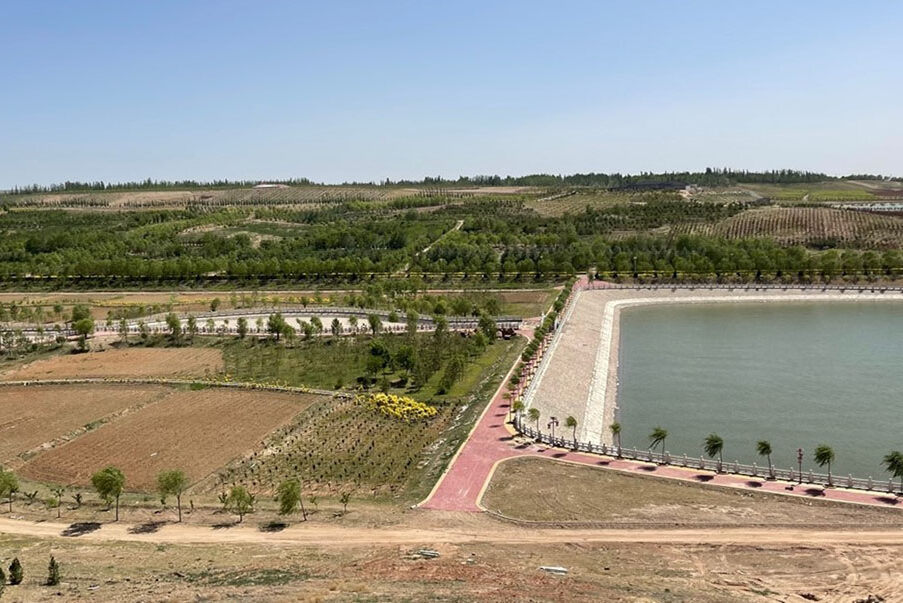East Asia Blog Series
Sustaining Agricultural Production through Water-Saving Irrigation
Zhiming Niu 20 Jun 2022
Sustainable farming and efficient water use can enhance high-value crop production and increase farmers’ income even in harsh environments.
Overview
A high poverty rate in rural areas of the Ningxia Hui Autonomous Region made it one of the priority regions for poverty alleviation in the PRC. Rural poverty is attributed to water scarcity, poor agriculture infrastructure, and unsustainable farming practices.
Since the late 1990s, the government has been promoting the growing of horticultural crops to improve farm productivity and income. A project funded by the ADB has helped Ningxia to increase its agricultural production by establishing modern farms, promoting sustainable farming practices, adopting water-saving irrigation systems, and enhancing local capacity.
Project information
44035-014: Ningxia Irrigated Agriculture and Water Conservation Demonstration Project
Project snapshot
- Approval date: 14 December 2012
- Closing date: 3 March 2021
- Total project cost: $106.40 million
- Financing: ADB ($70 million), Ningxia Hui Autonomous Region Government( $36.40 million)
- Executing agency: Ningxia Hui Autonomous Region Government
Context
Located in the northwest region, Ningxia has a total area of 66,400 square kilometers and a population of 6.2 million, of which 2.2 million (36%) belong to the Hui minority. The region is largely arid and semiarid (annual precipitation is less than 200 millimeters on average), with dry and harsh winters and hot summers.
Ningxia lags in terms of income and people’s well-being. At the time of project preparation in 2010, the region’s per capita gross domestic product (GDP) was CNY26,860 (about $4,000 today), below the national average GDP of CNY29,762. Income gaps persist as the average urban income was more than three times that of rural income. In 2011, more than one million people or about 25.6% of the region’s rural population were living below the national poverty line.
Agriculture is one of the main sources of income in the region. In the late 1990s, the government started promoting the planting of horticulture and high-value crops such as grapes, goji berry, and Chinese dates to help increase production and improve rural incomes.
Development Challenges
Poor land management practices and limited modern agricultural technologies and infrastructure have restrained the potential of farming, especially the value-addition of horticulture, in Ningxia.
Water resources are limited but flood irrigation is still widely practiced even for horticultural crops, resulting in huge volumes of water wasted in the fields and irrigation channels. In addition, extreme weather, such as a severe drought or flood, affects the productivity of vineyards and orchards in the region. More efficient water use is required to adapt to climate change impacts.
Solutions
The ADB-financed project helped to expand water-saving irrigation in agricultural development, promote sustainable farming practices, and strengthen the agricultural value chain through partnering enterprises with farmer households (mainly for grape growing) in Ningxia especially in Yinchuan, Ningxia State Farm, Hongsipu district, and Tongxin county.
Water-saving irrigation systems replaced traditional flood irrigation in the targeted vineyards and orchards. The systems comprise a storage pool supplying water, pipe networks, and pump stations that automatically regulate the flow and distribution of water to the fields. The drip irrigation pipes or hoses are placed on the fields on the plant root zone. Dissolved fertilizers are delivered to the crop through the irrigation system based on the soil testing results and application schedule. The improved irrigation systems reduced the water use to 70%–80% and the application of chemical fertilizers to about 50%–60%. The total irrigated area increased by 2,695 hectares—2,133 ha of vineyards, orchards, and water conservation farms; and 562 ha of shelterbelts.
The project established 180 ha and rehabilitated 823 ha of vineyards in Ningxia State Farm through improved farming practices, such as the application of organic fertilizers and integrated pesticide management. Vineyards were established in Hongsipu district (for fine wine making) and orchards of yellow-horn and Chinese dates in Tongxin county. Yellow-horn contain unsaturated fatty acids of up to 94%, making it suitable for high-end cooking oil production. Two demonstration farms were developed in Yinchuan: (i) a water-saving and conservation demonstration farm (440 ha) testing various practices, including protected agriculture (greenhouses) using automatic control systems; and (ii) a comprehensive modern agriculture farm (143 ha) showcasing farming practices for various plants and crops, integrated agrotourism, and protected agriculture facilities.
Two farms (Yuquanying and Nuanquan of the State Farm) were equipped with grape processing facility capable of crushing, pressing, and juice storing. Both also have monitoring systems. These became operational in 2018.
The water-saving irrigation and new farming technologies, such as protected agriculture, integrated fertilizer management, and contouring have been applied extensively in the project areas. The Ningxia State Farm has mainstreamed the quality monitoring and control system for its vineyards and wineries. The water use associations are extensively involved in irrigation management. More than 8,600 farmers were trained in water and soil conservation, sustainable horticultural management, and plant disease prevention and pesticide management. The capacities of cooperatives and water use associations were enhanced in sustainable horticultural management.
Results
The annual water savings reached about 3.11 million cubic meters (m3), with a significant decrease of water use from about 18,000 m3 per hectare under traditional flooding irrigation to 4,500 m3 per hectare.
The percentage of land under water conservation irrigation to total irrigated land in Ningxia Hui increased to 49% in 2020 (313,330 ha to 646,660 ha) from 19% in 2010 (89,000 ha to 466,660 ha).
Improved agriculture production has nearly tripled the average per capita rural income to CNY13,889 in 2020 from CNY4,675 in 2010. All grapes produced from the project vineyards have met the quality standards for associated wineries in Ningxia. At the project completion in 2020, the annual grape production increased to 3,720 tons or 169% of the original target. Chinese dates production also reached its target of 1,810 tons. The project also supported high-value agriculture, such as yellow-horn in Tongxin county, and protected agriculture in Yinchuan.
The demonstration farms showed promising agricultural development and high-value agriculture, which are likely to contribute to rural income improvement.
The coverage of expanded vegetation also increased carbon sequestration and soil carbon stock.
Lessons
Improvements in water use efficiency can support agriculture development without increasing water consumption. Crop lands could be expanded and irrigated by using water saved from existing agriculture and by applying highly efficient irrigation systems.
Water-saving technologies promote climate-resilient agricultural practices, particularly in dryland areas.
Modern agricultural farms, including the promotion of high-value crops such as grapes and yellow-horn and protected agriculture, can be effective models to increase productivity and farmers’ income and significantly contribute to poverty alleviation in the region.
References
Asian Development Bank (ADB). 2012. Report and Recommendation of the President to the Board of Directors: Proposed Loan to the People’s Republic of China for the Ningxia Irrigated Agriculture and Water Conservation Demonstration Project. Manila.
ADB. 2022. Completion Report: Ningxia Irrigated Agriculture and Water Conservation Demonstration Project in the People’s Republic of China. Manila.
Author

Zhiming Niu
Senior Project Officer (Environment), East Asia Department, ADB
This blog is reproduced from Development Asia.


